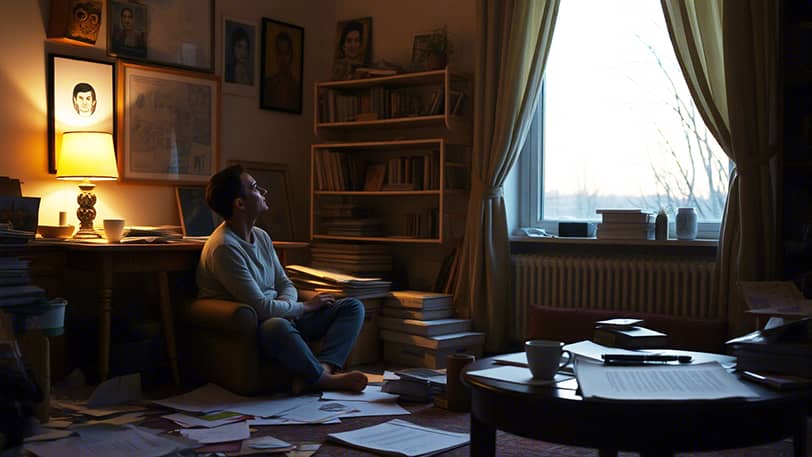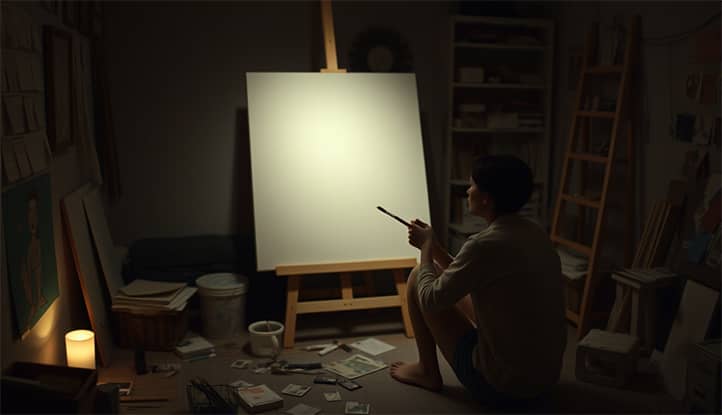Creative Block — a state familiar to anyone who has ever tried to create something new. It comes suddenly: yesterday, you effortlessly found solutions, generated ideas, and felt inspired, but today, you stare at a blank sheet or screen with a sense of utter emptiness. Thoughts seem frozen, every attempt to come up with something sparks irritation, and your usual methods no longer work. This isn’t just laziness or a lack of motivation—it’s a deep blockage of the creative process that can last for days, weeks, or even months.
Interestingly, creative block doesn’t discriminate between beginners and established masters. Even the most successful artists, writers, musicians, and inventors face periods of stagnation. Recall how Stephen King, in his memoirs, described moments when words “refused to come,” or how Leonardo da Vinci left paintings unfinished for years. This isn’t a sign of lacking talent—rather, it’s a natural part of the creative cycle. But why does it happen?
The reasons can vary: accumulated fatigue, fear of failure, external pressure, or simply the exhaustion of familiar ideas. Sometimes, a crisis arises due to internal conflicts—for example, when creativity stops bringing joy and turns into a routine. It’s important to understand that this isn’t a dead end but rather a signal: it’s time to change something. Recognizing the causes of the block is the first step toward overcoming it. And by knowing proven ways to break free from this state, you can not only regain inspiration but also discover new facets of creativity.
In this article, I’ll break down how to recognize creative block, why it occurs, and—most importantly—what to do when it feels like all your ideas have dried up. You’ll learn practical methods to get unstuck and realize that even in moments of creative “stagnation,” your potential hasn’t disappeared—it’s simply waiting for the right moment to emerge with renewed strength.

Why Does Creative Block Happen?
Creative block isn’t just a random “streak of bad luck”—it’s a natural process that always has underlying causes. It’s like an engine that suddenly stalls: to restart it, you need to figure out what went wrong. Maybe the fuel ran out, the filter is clogged, or it just needs time to cool down.
The same goes for creativity: when ideas stop flowing and inspiration vanishes, it’s a sign that something in the system has malfunctioned. Sometimes the problem lies in exhaustion, other times in fears or external pressure. By understanding the causes, you can not only overcome the block but also prevent it in the future. Let’s examine the five main “culprits” behind creative stagnation.
Emotional Burnout – Overload and Fatigue
Imagine your brain is a muscle. If you keep straining it without rest, exhaustion will eventually set in. The same happens with creative thinking: when you push yourself relentlessly (especially in multitasking mode), your resources deplete.
Signs of burnout:
- Physical fatigue — even after sleep, you don’t feel rested.
- Emotional emptiness — things that once brought joy now seem meaningless.
- Reduced concentration — difficulty focusing on tasks.
What to do? Give yourself time to recover. Sometimes, the best way to regain creativity is to forget about work for a few days, get some sleep, and change your surroundings.
Fear of Failure – Perfectionism and Self-Criticism
Many creative people are perfectionists. They want everything to be flawless, so they endlessly tweak, redo, and ultimately… never finish anything. The fear of “not being good enough” paralyzes: it’s better to do nothing than to risk making a mistake.
How it manifests:
- Endless doubts — “This isn’t original/deep/quality enough.”
- Procrastination — constantly putting off work “for later.”
- Comparing yourself to others — feeling like “everyone is better than me.”
What to do? Give yourself permission to make mistakes. Try the “bad first draft” technique: deliberately create something imperfect just to break through the creative block.
Routine and Lack of New Experiences – The Brain Needs “Fuel”
Creativity thrives on new impressions. If you do the same things day after day, the brain stops generating fresh ideas—it simply has nothing to draw from.
Examples of “fuel starvation”:
- Monotonous schedule — home–work–home, with no new places or events.
- Information diet — you’ve stopped reading, watching, or exploring new things.
- No experimentation — you only do what you already know how to do.
What to do? Shake up the routine: visit an unfamiliar place, try a new hobby, or talk to people from a different field. Even small changes (like new music or an unusual walking route) can spark ideas.
External Pressure – Deadlines, Expectations, Criticism
Sometimes, creative block is triggered not by internal factors but by external circumstances. Tight deadlines, client demands, criticism, or the fear of disappointing others—all of this creates stress that stifles creativity.
How it looks:
- Creativity “on demand” — when you have to produce ideas “on schedule.”
- Fear of judgment — “What will others think?”
- Loss of enjoyment — the process turns into a chore.
What to do? Find a balance between external demands and internal freedom. Sometimes it helps to:
- Have an honest conversation with clients/employers about deadlines.
- Create something “just for yourself,” without outside judgment.
- Remind yourself: criticism isn’t a verdict—it’s part of growth.
Loss of Motivation – When Creativity Loses Its Meaning
Sometimes, a crisis arises not from fatigue or fear but because the “why” disappears. Maybe your goals have shifted, or old motivations no longer work. Or perhaps you’ve simply forgotten why you started in the first place.
Signs:
- Feeling of routine — “I’m doing this mechanically, without joy.”
- Questions like “Why?” — no clear sense of purpose.
- Envy of others — it seems like they have passion, but you don’t.
What to do? Return to the roots:
- Remember what initially inspired you about this work.
- Reassess your goals—maybe they’re outdated and need updating.
- Allow yourself a break—sometimes motivation returns on its own.
Creative block doesn’t appear out of nowhere—it always has causes. The good news: once you recognize them, you’ll know which direction to move in. Some need rest, others need to stop chasing perfection, and others need new sources of inspiration. The key is not to blame yourself but to see the crisis as a signal for change.

How to Recognize a Creative Block?
A creative block often creeps up unnoticed. At first, it may seem like ordinary fatigue or a temporary drop in productivity, but the condition gradually worsens. Many creative people don’t immediately realize they’re facing a block, attributing it to a bad mood or external circumstances. However, there are clear signs that can help you recognize this state and take action in time.
A distinctive feature of a creative block is that it affects not only your productivity but also your emotional state. You may feel irritation, emptiness, or even despair when trying to create something new. It’s important to notice these signals early to avoid making the situation worse. Let’s break down the main symptoms of a creative block to help you make an accurate “diagnosis.”
Procrastination and Avoidance of Work
The first red flag is usually chronic procrastination. You find countless reasons not to start working: suddenly remembering urgent chores, cleaning an already tidy desk, or endlessly scrolling through social media. At the same time:
- You feel guilty about inactivity but can’t help it.
- You invent “preparatory stages” for yourself (e.g., “First, I’ll study all the theory”).
- You notice that even simple tasks now require enormous effort.
This isn’t ordinary laziness—your brain is protecting itself from the stress associated with the creative process.
Feeling of “Emptiness” and Lack of Ideas
A hallmark of a creative block is the sense that your “inner well” has run dry. You:
- Stare at a blank page/screen with a feeling of complete emptiness.
- Catch yourself thinking that all ideas seem clichéd or already used.
- Can’t even generate “bad” options, though it used to be easy.
- Feel like your thought processes have slowed down.
This is especially alarming when the state lasts not just a day or two, but weeks.
Irritation and Apathy Toward Your Own Work
Emotional changes are a key marker of a creative block:
- Work that once brought joy now only irritates you.
- Looking at your past projects, you feel no connection to them.
- You get the urge to delete or destroy everything.
- Thoughts of quitting creativity altogether arise.
- Physical symptoms: heaviness in the chest, headaches when trying to work.
It feels like you’ve “outgrown” your creativity—but without the joyful anticipation of a new phase.
Constant Comparison with Others
During a creative block, unhealthy comparisons become especially intense:
- It seems like everyone around you is productive and talented—except you.
- You obsess over others’ successes while forgetting your own achievements.
- You feel “not good enough” for your profession.
- Even compliments make you doubtful (“They’re just being polite”).
This symptom is particularly dangerous because it creates a vicious cycle: the more you compare, the more your creativity gets blocked.
What’s Important to Remember
All these symptoms are a normal psychological response to creative overload. They don’t mean you’ve “lost your talent” or “can’t create anymore.” Rather, they’re a sign that your creative self needs a break and a reset. The key is not to blame yourself and to understand that creative blocks happen to everyone—and they’re temporary.

Practical Ways to Overcome Creative Block
When creative block hits hard, it may seem like there’s no way out. But the good news is that this condition can be overcome. The key is not to try “breaking through the wall with your forehead,” but to use proven methods that gently pull you out of creative stagnation. All the techniques listed below work in three directions: they remove psychological blocks, restore energy, and spark a flow of new ideas.
It’s important to understand: there is no magic pill for creative block. Different methods work for different people. Try several approaches and create your personal “rescue kit.” Let’s explore the most effective techniques that have helped thousands of creative people worldwide.
Resetting Your Mindset
When the brain fixates on a problem, it stops seeing alternatives. These methods help “rewire” habitual thought patterns.
a) The “Bad Ideas” Method — deliberately come up with the most ridiculous, stupid, or absurd solutions to a problem. For example:
- Host a “bad ideas session” — spend 10 minutes generating only obviously terrible options.
- Pick the most absurd idea and try to refine it.
- Create an “anti-masterpiece” — intentionally make your work as bad as possible.
Paradoxically, truly fresh solutions often emerge from such experiments. This method relieves the pressure of perfectionism.
b) Changing the Format — if you’re:
- A writer — try writing poetry instead of prose.
- An artist — switch from paints to pencils or digital tools.
- A musician — play an unfamiliar instrument.
- A designer — create work in a style that’s uncharacteristic for you.
New tools and formats force the brain to seek unconventional solutions, bypassing established patterns.
Restoring Energy
Creativity requires enormous mental resources. These methods help replenish them.
a) Rest and Digital Detox:
- Take a “creative day off” — a complete ban on work-related activities.
- Turn off all notifications for 24 hours.
- Try an “information diet” — at least one day without news or social media.
b) Physical Activity:
- A 30-minute walk in a new neighborhood boosts creativity by 60%.
- Dancing to your favorite music (especially improvising).
- Yoga or stretching — releases physical tension linked to stress.
c) Meditation and Mindfulness Practices:
- The simple “5-4-3-2-1” technique: Name 5 things you see, 4 you hear, 3 you feel, 2 you smell, and 1 you taste.
- A 10-minute breathing meditation before starting work.
- Keeping an emotion journal — helps uncover hidden sources of stress.
Finding Inspiration
When your own resources are depleted, seek new sources of inspiration.
a) Consuming Content Unrelated to Your Field:
- Artists — read science fiction.
- Writers — visit contemporary art exhibitions.
- Designers — study architectural styles.
- Musicians — watch silent films.
b) Travel (Even Mini-Trips):
- Visit a part of town you’ve never been to.
- Take a short trip to a nearby town (even for a few hours).
- Change your usual commute route.
- Spend a day as a tourist in your own city.
c) Connecting with Creative People:
- Attend a creative meetup or workshop.
- Start a collaborative project with someone from another field.
- Find a “creative accountability partner” for mutual support.
Working Through the Block with Action
Sometimes, the best way to overcome a block is to start acting—even if it feels forced.
a) The “Morning Pages” Method (from Julia Cameron’s practice):
- Every morning, fill 3 pages with stream-of-consciousness writing.
- Write whatever comes to mind, without editing.
- You can destroy what you’ve written immediately—it’s about the process, not the result.
b) The Pomodoro Technique:
- 25 minutes of work — 5 minutes of rest.
- Start with the simplest tasks.
- The focus is not on results but on building a habit of consistent work.
c) Collaging and Visualization:
- Create an “inspiration board” from random images.
- Try automatic drawing (with your eyes closed).
- Make a free-form mind map for your project.
Important Reminder
Don’t try to apply all methods at once. Choose 2-3 that resonate with your current state and try them for a week. Creative block is not an enemy but an opportunity to rethink your approach to work and discover new facets of your talent. Sometimes, the most powerful breakthroughs happen right after periods of stagnation.

What to Do When the Crisis Drags On?
When a creative block lasts for weeks or months, it stops being just a temporary productivity slump. A prolonged crisis is a signal that superficial methods won’t work anymore. At this stage, many make a mistake—either continuing to fruitlessly struggle or giving up on creativity altogether. But there’s a third way: deep work on the root causes and rethinking your approach.
A prolonged creative block is like nature’s winter hibernation—everything seems frozen, but in reality, it’s a time of internal restructuring. Such periods often precede major creative breakthroughs. Your task isn’t to force yourself to “squeeze out” ideas at any cost but to create conditions for inspiration to return naturally. Let’s explore three strategies for dealing with a prolonged creative block.
Analyzing Deep-Seated Fears (Therapy Might Be Needed)
When the block persists, it’s worth looking deeper than surface-level reasons. Often, the root of the problem lies in unconscious fears and limiting beliefs:
How it manifests:
- Fear of success (a subconscious belief that fame/money will corrupt you).
- Fear of being undervalued (deep insecurity about your uniqueness).
- Traumatic experiences (e.g., suppressed childhood creativity).
- Inner conflicts (a clash between creativity and “adult” life).
What to do:
- “Letter from Fear” technique — let your fear speak out on paper.
- Make a list: “What’s the worst that could happen if I…?” — often, fears turn out to be exaggerated.
- Trace the roots of the fear—when did this feeling first appear?
- If you can’t figure it out alone, consult an art therapist or psychologist specializing in creative blocks.
Case study:
Writer Maria couldn’t finish her novel for 2 years. Therapy revealed she subconsciously feared repeating the fate of her aunt, a poet who took her own life after literary success. Recognizing this fear became a turning point.
Temporarily Abandoning the Project – Switching to Something Else
Sometimes, the best way to save a project is to step away from it for a while. It sounds paradoxical, but often “letting go” is what leads to a solution.
How to do it right:
- Set a clear deadline for the break (e.g., 1 month).
- Physically remove project materials from sight.
- Engage in the opposite type of activity:
- If stuck in writing — take up painting.
- If struggling with design — start a video blog.
- If blocked in music — try sculpting.
Important rules:
- The new project should be completely different but still creative.
- Don’t set ambitious goals—it’s just a “playground.”
- Give yourself permission not to return to the old project if the desire doesn’t resurface.
Real-life example:
Designer Anton spent six months unable to create a logo for an important client. After switching to street photography, he unexpectedly found inspiration in the typography of an old sign a month later.
Accepting the Crisis as a Growth Phase
Sometimes, the most productive thing is to stop fighting the block and accept it as a necessary stage of development.
How to turn the crisis into a resource:
- Keep a “Crisis Journal” — record insights and observations.
- Practice “creative inaction” — set aside time when you consciously create nothing.
- Study biographies of great creators—you’ll see they all had periods of stagnation.
- Define what this crisis is teaching you (maybe you need new skills or revised goals).
Specific exercises:
- Make a list: “What I Can Do Instead of Creating Right Now.”
- Create a collage or mood board reflecting your crisis.
- Write a letter to yourself from the future, where this crisis is already behind you.
Wisdom from famous creators:
Composer Igor Stravinsky said: “Periods of so-called barrenness are the times when your material is being digested and ripening. Don’t try to hasten this process.”
Final Advice
A prolonged creative block isn’t the end of your creative journey—it’s an essential part of it. Those who learn to navigate these periods emerge renewed, with fresh creative possibilities. Allow yourself this time for reflection—perhaps something far more important than just another project is taking shape within you.

Conclusion
A creative block isn’t a failure but a natural part of any creative process—as inevitable as the changing seasons. It may feel like a dead end, but in reality, it’s more like a turn leading to a new path. Think of how nature lies dormant in winter, only to bloom with renewed vigor in spring. Similarly, creative stagnation is a time of internal restructuring, when the seeds of future ideas mature deep within. The key is not to wage war against yourself during these periods but to move through them mindfully, maintaining trust in your own process.
The crucial thing is to abandon destructive self-criticism. How many masterpieces were never created simply because their authors decided they were “no longer capable”? When it seems like all ideas have dried up, it’s often just an illusion created by fatigue or fear.
Instead of berating yourself for unproductive attempts, try radically new approaches: change your environment, tools, or work rituals. History is full of examples where creative breakthroughs came precisely when people dared to experiment—writing with their left hand instead of their right, working at unusual hours, or starting a project “just for themselves,” without worrying about the outcome.
Inspiration can be found in the experiences of great creators who faced similar crises. J.K. Rowling, while creating Harry Potter, was going through a deep personal and creative crisis as a single mother on welfare. Agatha Christie, when stuck on a plot, would wash dishes—the monotony freed her mind for new ideas. These examples remind us: a block isn’t proof of a lack of talent but a sign that you’re growing.
So if today you’re staring out the window feeling like all your ideas are gone—remember, it’s temporary. Give yourself this break. Trust the process. Sometimes, the most fruitful creative periods begin exactly where everything seems to have stopped.




